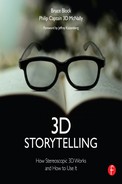Book Description
3D Storytelling is the ultimate guide for directors, cinematographers, producers, and designers of stereoscopic 3D movies and videos. With an emphasis on the aesthetic over the technical, this book is an essential foundation for showing you how to use 3D creatively to tell a story.
Hollywood producer Bruce Block and Dreamworks stereoscopic supervisor Philip Captain 3D McNally blend their vast real-world experience and teaching skills to help you learn how to:
* Think in 3D
* Integrate 3D design into your script or story
* Direct and design the 3D depth of your shots
* Use stereoscopic windows
* Work with the depth cues in 3D
* Create a comfortable viewing experience for the audience
* Plan editing and directorial considerations for 3D
* Understand closed, open, and unstable 3D space
Brimming with practical information that can be immediately applied to your 3D production, the book also features interviews with some of the industry’s leading stereographers, as well as 3D diagrams and photographs that illustrate how 3D works, how it can be controlled in production, and how 3D can be used to tell a story.
